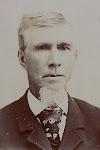Charles Ducklow as an Inventor
[Updated November 30, 2008]
[Updated November 30, 2008]
At the very start of the 1900s only half of the households in the United States had an icebox to keep food cool, while the other half of the nation had no cooled storage at all. The issue of icebox ownership was not necessarily the cost of an icebox itself, but rather the recurring cost of ice. Ice was expensive because it had to either be cut from ponds, lakes or rivers or manufactured by an industrial process. On
 ce made or harvested, it was stored until needed, and then delivered regularly by an ice service for a fee.
ce made or harvested, it was stored until needed, and then delivered regularly by an ice service for a fee.Right: Three icebox models
Photo Source: Wikipedia Source
Those that owned iceboxes needed to pay close attention to the size of the ever-shrinking ice block that kept their food cool. The need to monitor the rate at which ice was melting was important chore to prevent food spoilage. Not having enough ice would result in too warm of temperatures and cause high bacteria counts and lead to illness and rotten food. Ordering ice too early was a waste of both ice and money; and too much ice in the cooler had the unintended consequence of making parts of the icebox into a freezer.
Apparently accurate ice monitoring was problematic. Once you purchased a block of ice it was difficult to gauge how fast the block was shrinking. A simple visual inspection of the block was often a poor method because one could not recall the size of the block from prior inspections.
Charles Ducklow [see footnote] pondered this issue in depth. He and two of his associates saw the need for a mechanical solution to measure how much ice had melted over time. So in about 1906 or so, Charles, Martin Kiev, and Herman Jaeger invented a mechanism to measure ice shrinkage by means of weighing. Knowing the rate of shrinkage would in-turn allow one to more accurately gauge a schedule for replenishing the ice block.
The three men thought their idea was cleaver and unique enough to be patented. They described their concept, completed the application papers and submitted all to the U.S. Patent office. Collectively, they no doubt saw the possibility of that their patent might be picked-up by an icebox manufacturer. If this came to be, the sale of either the patent outright or negotiated royalties from the patent use could have produced a nice income for the three men.
The news that a U.S. Patent was issued to the men was reported in the Waukesha Freeman newspaper on February 28, 1907 [see footnote]. However, this is where the story seems to end. There is no located evidence that anything came from their patented idea. This is often the case with patents. Patented ideas are often unique solutions to problems, but other solutions also exist which can be used at either lower manufacturing or business cost. Getting a patent issued is not an approval by the government that your idea is best and should be used in a product, but rather just a recognition by the government that you were the first to describe the idea and have therefore have rights regarding the use of the idea.
The need for measuring ice shrinkage in an icebox had a market window of about thirty years. By the late 1920s the General Electric Company had designed an electric refrigerator for the masses. The "Monitor-Top" refrigerator introduced in 1927 became widely accepted as they were priced at about $300. Many middle-class American’s could afford them. Some utility companies who were eager for increased electric use offered them to households on $10 a month installment plan built into their monthly bill. Over one million units of GE's Monitor-Top were produced, with the last models sold in the late 1930s. Apparently Monitor-Tops were built so well that hundreds, or perhaps even thousands of the units are still functional today.

Left: GE 1920s Era "Monitor-Top" Refrigerator
The mechanism was on top to allow the considerable heat
to radiate up away from the box
Photo Source: Wikipedia Source
The mechanism was on top to allow the considerable heat
to radiate up away from the box
Photo Source: Wikipedia Source
❧
Source: http://www.antiqueappliances.com/monitor_top_refrigerators.htm link
Source: http://en.wikipedia.org/wiki/Refrigerator link
Source: http://en.wikipedia.org/wiki/Icebox link
Footnote: Waukesha Freeman, Feb 28, 1907, page 3: “Charles Ducklow, Martin Kiev and Herman Jaeger last week received letters patent for a new and useful improvement for refrigerators by the initial weight of ice and amount consumed may be registered the object of invention being to provide a registering means whereby the initial weight of ice deposited therein is indicated the register mechanism being so arranged as to show thereafter the exact amount of shrinkage of the ice caused through atmospheric conditions.”
Footnote: The specific Charles Ducklow referenced in the Waukesha Freeman article is not entirely clear. It could easily be one of two Charles Ducklows of the period with connections to the Waukesha area:
(1) It could refer to Charles Ducklow, Thomas and Elizabeth's seventh son, born in 1853. In 1907 Charles was 49 years old, and a well established businessman in Wilton Wisconsin. Charles was also active in the Masons in Wilton, Sparta and LaCrosse, offering him many business connections. He also no doubt maintained relationships with Dodge and Waukesha County residents from his childhood.
(2) The article could also refer to Charles Henry Dukelow, who also used the spelling Charles Ducklow. He was born in 1866, son of Richard Dukelow, Thomas' half-brother; Charles Henry was Thomas and Elizabeth's half-nephew. Charles Henry was about 40 years old in 1907 and known as a carpenter of the Waukesha area. Because of his residence it would seem that is why the Freeman published the the article in reference to him. Another piece of open research.
❦


No comments:
Post a Comment